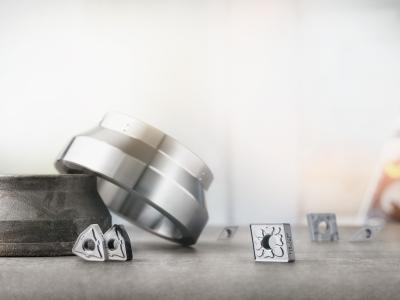
Seco Tools has three new grades specifically for stainless steel turning featuring the company’s latest Duratomic generation and its Used-Edge Detection technology. The new TM grades TM1501, TM2501 and TM3501 secure operations and improve productivity in materials ranging from austenitic stainless steel to high-alloyed, super- duplex stainless steels. The expanded range of TM inserts also includes new geometries with chipbreakers optimized for finishing and medium-roughing applications in stainless steel.
TM1501 is designed for the highest level of speed, productivity and wear resistance in stable continuous cut applications for austenitic stainless steel components. The first-choice grade for any low to medium-alloyed stainless steel, TM2501 excels as a general grade that provides long tool life and toughness across the widest application area. And a brand-new grade for the toughest high-alloyed stainless steels, including duplex and super-duplex stainless steels, TM3501 also offers good performance across all stainless steel applications.
The addition of the unique FF1 chipbreaker for the TM3501 grade provides superior chip control in stainless steel finishing, while the new MR3 and M3 complements MF4 and M5 in medium-roughing applications.
These three Duratomic grades feature innovations based on world-leading coating chemistry developments adapted to manufacturers’ application needs. In addition to offering superior mechanical and thermal properties, this coating also provides the chrome-colored Used-Edge Detection technology, which makes every edge count and reduces potential waste.
Contact Details
Related Glossary Terms
- chipbreaker
chipbreaker
Groove or other tool geometry that breaks chips into small fragments as they come off the workpiece. Designed to prevent chips from becoming so long that they are difficult to control, catch in turning parts and cause safety problems.
- stainless steels
stainless steels
Stainless steels possess high strength, heat resistance, excellent workability and erosion resistance. Four general classes have been developed to cover a range of mechanical and physical properties for particular applications. The four classes are: the austenitic types of the chromium-nickel-manganese 200 series and the chromium-nickel 300 series; the martensitic types of the chromium, hardenable 400 series; the chromium, nonhardenable 400-series ferritic types; and the precipitation-hardening type of chromium-nickel alloys with additional elements that are hardenable by solution treating and aging.
- turning
turning
Workpiece is held in a chuck, mounted on a face plate or secured between centers and rotated while a cutting tool, normally a single-point tool, is fed into it along its periphery or across its end or face. Takes the form of straight turning (cutting along the periphery of the workpiece); taper turning (creating a taper); step turning (turning different-size diameters on the same work); chamfering (beveling an edge or shoulder); facing (cutting on an end); turning threads (usually external but can be internal); roughing (high-volume metal removal); and finishing (final light cuts). Performed on lathes, turning centers, chucking machines, automatic screw machines and similar machines.
- wear resistance
wear resistance
Ability of the tool to withstand stresses that cause it to wear during cutting; an attribute linked to alloy composition, base material, thermal conditions, type of tooling and operation and other variables.

